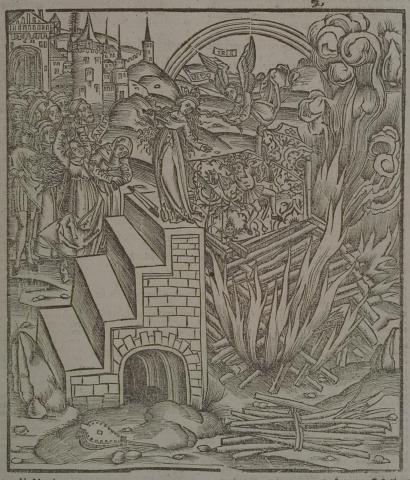Annotations
In the right half of the image is a large pyre, which Dido has built on the pretense of burning everything Aeneas left behind him (494-7). At the top of the pyre is the bed in which Aeneas slept, which is shown with an image of Aeneas on it, a representation of the things he left (494-7). Below the pyre are a bellows and a bundle of kindling, tools necessary to make a good fire. On the left, a crowd of onlookers, including Dido's sister Anna and the nurse Barce, shown wearing a wreath on her head (632-3, 637), stands watching what they think will be a sacrifice and ritual pyre meant to free the queen of her love for Aeneas. Dido stands at the top of a set of steps next to the pyre, so that she stands just slightly above the burning pile of wood. She plunges a sword, a gift from Aeneas, into her breast (646-7, 663-5), and begins to fall in the direction of the pyre. In Vergil's text, Dido climbs up onto the pyre and onto the bed itself, where she makes a small speech (651-61) and then falls on her sword, which is the honorable way to commit suicide. Above the pyre, Iris, sent by Juno, prepares to cut the golden lock of hair from the queen's head, to send her soul to the underworld (693-705). (Katy Purington)
Woodcut illustration from the “Strasbourg Vergil,” edited by Sebastian Brant: Publii Virgilii Maronis Opera cum quinque vulgatis commentariis expolitissimisque figuris atque imaginibus nuper per Sebastianum Brant superadditis (Strasbourg: Johannis Grieninger, 1502), fol. 228r, executed by an anonymous engraver under the direction of Brant.


Sebastian Brant (1458–1521) was a humanist scholar of many competencies. Trained in classics and law at the University of Basel, Brant later lectured in jurisprudence there and practiced law in his native city of Strasbourg. While his satirical poem Das Narrenschiff won him considerable standing as a writer, his role in the transmission of Virgil to the Renaissance was at least as important. In 1502 he and Strasbourg printer Johannes Grüninger produced a major edition of Virgil’s works, along with Donatus’ Life and the commentaries of Servius, Landino, and Calderini, with more than two hundred woodcut illustrations. (Annabel Patterson)